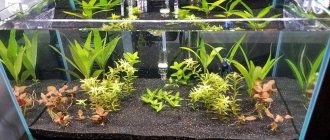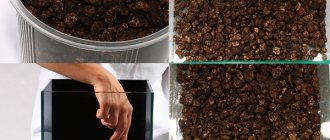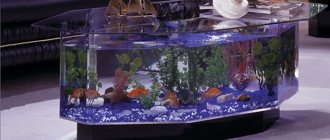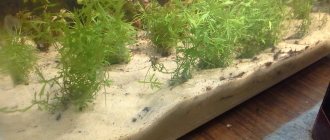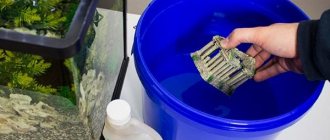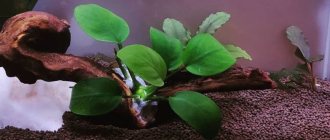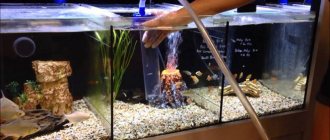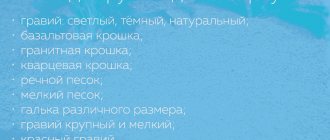Home › Aquarium equipment ›
( 3 ratings, average: 2.00 out of 5)
Nutrient aquarium soil is the key to success in creating an aquarium herbalist, aquadesign, the key to growing beautiful and healthy aquarium plants and a guarantee that they will grow quickly enough. Aquatic aquarium plants with a root system are essentially the same as garden plants. A complex root system helps plants obtain the necessary nutrients from the soil: iron, potassium, magnesium, nitrogen and many others. These nutrients play a key role in the color, health and growth rate of plants in the aquarium. Nutrient soil will also help combat algae growth, allowing the plants to outpace the growth of single-celled aquarium pests by absorbing nitrates, the algae's main food source.
Below we will discuss popular and not so successful proven nutrient soils, how they work, price and where to buy.
What is nutrient soil for an aquarium?
Nutrient soil is a specially developed commercial soil for an aquarium with live plants based on soil, clay, nutritious mineral components necessary for the life of plants, and sometimes contains bacteria necessary for the normal life of the aquarium.
Nutrient soil is usually a natural color, can be all shades of brown, from very light to dark, almost black with a reddish (a sign of the presence of iron in the soil) or grayish (large amount of clay) tint. Nutrient soil is always lighter and more porous than ordinary rounded “bare” soil. The fraction of nutrient soil usually ranges from very fine (1-3 mm) to coarser (3-4 mm). The degree of “lightness” and porosity depends on the clay content.
Nutrient soil may have a light, pleasant natural smell of earth or peat. Usually there is no need to rinse before placing in the aquarium, but these features may be indicated on the packaging.
Proper laying of soil
The recipe from the above components is placed on the aquarium bottom, up to 4 cm thick. Coarse sand or pebbles are placed above. Most aquascapers like to use fine pebbles, up to 3 mm in size.
This type of two-layer soil is very useful for vegetation. Its lower part promotes nutrition, and the upper part protects organic components from rapid leaching and loss of their properties.
You can also add a bacterial activator here, then the benefit of this substrate increases due to the formation of a colony of beneficial bacteria in it.
See how to properly lay soil in an aquarium:
Why do you need nutrient soil in an aquarium?
Nutrient soil is necessary for living plants with a root system. However, most long-stemmed and rosette plants can easily get by with regular “bare” soil, with an additional nutrient substrate, possibly consisting of the same nutrient soils, in order to save money.
Ground cover plants are plants that need nutritious soil to thrive. The roots of these plants are very small and delicate; it is difficult for them to break through heavy rounded soil, even of the finest fraction. A light nutritious soil for them is just what the doctor ordered. In addition, to form a “carpet” they need macro and micro nutrients more than other plants. Plants such as Glossostigma or Hemianthus cuba are unlikely to form a nice thick and green mat in an aquarium with plain soil.
Also, nutritious soil will be useful for all plants with leaves of any red shade - iron-containing soil will give them all the necessary elements.
Another feature of nutrient soils is the ability to reduce water hardness and increase its acidity, which is often used by lovers of freshwater aquarium shrimp, especially caridina shrimp, such as red and black crystals. It is these shrimp that urgently need low-hardness water. In addition, beneficial bacteria and protozoa, which mainly feed young shrimp, grow more actively on nutrient soils, so it is much easier to get offspring from them in an aquarium with nutrient soil, and the survival rate of young animals is higher. There are even special nutrient soils for aquariums with shrimp: Fluval shrimp stratum, Shirakura.
However, some aquarium plants also need softer acidic water, and nutritious soils will help you with this.
Also, if you are a beginner aquarist and have decided to create your first herbal tank (an aquarium with a variety of live plants), then nutrient soil is what you need. With it you will be much less haunted by failures!
Nutrient substrate
This is one of the important elements of the aquarium. Due to this mixture, plants grow and are filled with useful substances.
There are several types in nature:
- Naked . To put it in simple words, these are ordinary pebbles, pebbles, sand, etc. There are no nutrients in such soil. And for the plants to have something to eat, a certain amount of time must pass. All types can be found in this article.
- Nutrient substrates. They are placed on the bottom of your vessel (about 2 cm thick) and the main soil is sprinkled on top.
- And of course nutritious . This is already complete and living soil, which is saturated with useful substances and bacteria.
Requirement calculation
It is very difficult to determine in advance how much nutrient soil you will need for your aquarium: they all have different porosity and volume. You can only take into account the various factors that we will look at. You should also know that nutrient soils are quite expensive, so they are rarely used for aquariums with a volume of more than 60 liters, most often for nano aquariums with a volume of 10 l, 20 l, 30 l. For larger aquariums, it is more common to use nutrient substrates or nutrient soil as a nutrient substrate.
For aquarium plants, a layer of soil on average of 3-5 cm is required. For ground cover plants and plants with large root systems, AT LEAST 5 cm.
Formula for calculating soil for an aquarium:
Aquarium length (cm) x Aquarium width (cm) x Soil layer (cm) / 1000 = Soil volume in kg.
For example, consider the usual version of a 30 liter cube (NanoCube) from Dennerle:
30 cm x 30 cm x 5 cm / 1000 = 4.5 kg.
The calculation, of course, is rough, you may not have enough gravel or you may have some left over, but it works. Most likely, a 4 kg package of Fluval from Dennerle will be just enough for the specified aquarium. As an example, I’ll say that 3 kg of ADA soil is enough to start an aquarium with a volume of 23 liters (35 x 25 x 27).
If you use nutrient soil as a substrate, the calculation is the same, only you take a layer for calculation not 5 cm, but say, 2-3 cm. Thus, for an aquarium of 60 liters (30x57x35) for a 2 cm substrate you will need 3.4 kg.
Quartz sand for aquarium and basalt chips
If we talk about quartz sand, it cannot always be used. If we are talking about plants, they cannot develop normally only in a sandy environment. It doesn't have the right amount of nutrients. Therefore, although quartz sand for an aquarium looks very stylish, it must be used very carefully. It is suitable for an artificial pond in which there are no living plants. But even in this case, before use, such a composition must not only be thoroughly rinsed, but also calcined.
Marble basalt chips and quartz sand are used in the so-called white aquarium soil. It should be borne in mind that such components can also affect the composition of water, changing its alkaline balance and hardness. Nutrient soil for the aquarium itself should be a substrate containing macro- and microelements. It will allow the plants to develop fully, and the fish will receive the necessary nutrients. The color of the fish and the algae themselves even depend on the quality of the substrate.
Starting an aquarium on nutrient soil and caring for it
In general, starting an aquarium on a nutrient mixture is not much different from starting on regular soil. Whether or not rinsing is necessary depends on the manufacturer (read on the packaging).
Key Features:
- It is better to plant plants in an aquarium filled 1/3 with water, rather than in dry soil.
- During the first week, additional application of liquid fertilizers is not required.
- For the first 2 weeks, it is better to do water changes every 3 days.
You can see how to start an aquarium on nutrient soil using the example of starting an aquarium on Fluval soil.
How a substrate for aquarium plants can affect the biological environment
It is worth paying attention to the fact that most aquariums usually grow quite a large amount of greenery. If you are the owner of just such an artificial reservoir, then in this case it is necessary to choose the right soil. It will be able to enrich the roots, leaves and other parts of plants with all the necessary nutritional components. Much depends on the greenery itself.
Some people don’t really think about what plants should be in the aquarium, so they don’t plant anything at all. But, if we are talking about a serious hobby, then you must make sure that there are plants in the pond. For example, duckweed, elodea, hornwort, and moss are considered the most unpretentious.
Some aquarists make their own soil. However, it is necessary to remember that it will be necessary to maintain a certain biological balance inside the artificial reservoir. The fact is that an aquarium is a closed ecosystem, so if you make even the slightest mistake, the plants may start to get sick. If this happens to them, it will negatively affect the fish themselves and other living organisms in the container.
Many novice fish lovers create nutritious soil for aquarium plants by analogy with a greenhouse. They mix peat, manure, clay and soil, and then pour the resulting mixture onto the bottom of an artificial reservoir. However, such compositions most often have a negative effect on all inhabitants of the aquarium.
For example, it is worth noting that peat and clay are components that need to be used in the smallest proportions. Some professionals use such mixtures exclusively as fertilizer for very young plants. Besides this, it all depends on the specific water that is in the aquarium. The fact is that peat may not always be useful, since it has a softening effect on the aquatic environment. This negatively affects the health of the fish.
Seachem Fluorite Aquarium Nutrient Mix
Sold in 7 kg packs. In Ukraine at the moment it costs over 900 UAH. per package, it costs about $28 on Amazon.
Seachem Fluorite is a crushed porous gravel for natural planted aquariums. Essentially it is specially prepared “clay gravel”. The advantage of clay as a substrate is that it contains an extremely high amount of iron. This is especially beneficial for red plants as they use iron for their bright red color. The substrate may be dusty due to clay, so it must be washed before use to remove microparticles. However, the water may be cloudy when first started, and may become cloudy during the first water change. This is not dangerous for the aquarium population.
Seachem Fluorite can be used on its own or mixed with other plain gravel to help you save money.
Advantages:
- Great for a planted aquarium.
- High iron content, which is very good for red plants.
- Can be mixed with other soil.
- The soil has long been tested and has proven itself.
Flaws:
- The water in the aquarium may become cloudy when starting up.
- The water may become cloudy during water changes.
- Too high in iron but low in other nutrients.
- Red color.
DIY nutritious soil
If the types of substrate sold in pet stores do not suit the aquarist, then you can build a substrate for the aquarium with your own hands. There are many recipes for making a nutrient substrate, but the most universal and widespread is the recipe for two-layer soil, consisting of the following substances:
- Coal - it acts as an absorbent and is necessary to cleanse the substrate of harmful elements. It should be noted that carbon has the unpleasant property of releasing accumulated harmful elements into the liquid, so the mixture where activated carbon is used in the aquarium must be replaced every 10 months.
- Clay - it is divided into several varieties depending on the place of extraction: red, forest, and gray. For artificial reservoirs, the best option is gray clay. The red one contains a lot of iron, and the lake one contains humus.
- Sorbent is an additive that binds components. Experienced aquarists use “Vermiculite,” which preserves beneficial substances without allowing instant dissolution in water.
- Peat is a source of organic matter that nourishes the roots of flora. In an aquarium, experts advise using the granular type, since when using the forest type of peat, the soil in an artificial reservoir will quickly turn sour.
- Organics - crushed fallen leaves are used as organics: oak, maple, or aspen, however, each type of them has disadvantages. Experts advise using coconut fiber, which decomposes slowly and has proven to work well.
- Sand or pebbles are the base for the soil. Quartz sand in an aquarium helps remove toxic substances from the water.
Nutrient soil ADA Aquasoil “Amazonia”
Sold in various packages (2l, 3l, 6l, 9l). It’s quite possible to find it on sale in Ukraine and Russia. Costs from 400 UAH. (1500 rub.) per pack of 3 liters.
Nutrient soils from Ada have long proven themselves and are known throughout the world, and are widely used by Ukrainian aquascapers. In the top photo is an aquarium launched on the soil of Hell by one of, I’m not afraid to say it, the best aquatic designers in Ukraine. Ada Amazonia is a high quality product, used by Amano himself. There are several reasons for the popularity of Ada Amazon soil. This is a dark colored soil and dark color is known to help improve the color of aquarium fish and shrimp. Ada soils are also pH buffers, maintaining it at around 6.8. This level is suitable for most fish in the Amazon basin. Ada Amazonia is a premium nutrient soil; it gives plants everything they need for rapid growth, however, it costs much more than many other nutrient mixtures.
ADA Amazonia is prepared from black soil rich in organic matter, which supports the growth of most aquatic aquarium plants.
All such nutrient soils perform their functions for about 3 years, but over time the granules disintegrate and turn into dirt.
Advantages:
- Used by Amano himself!
- Ideal for ground covers and other small plants.
- In addition to micro elements, it is charged with macro elements.
- Ideal for shrimp.
- Dark color improves the coloration of fish.
- Tested by thousands of users on thousands of species of fish and plants.
Flaws:
- Extremely expensive.
- Over time, the texture collapses (blurs).
- Lowers pH (good for shrimp and Amazon fish).
Main types of aquarium soil
It should be noted that there is no strict classification of aquarium soils, but most aquarists agree that they can be divided into the following groups, basing the classification on their origin:
- Natural - crushed stone, gravel, pebbles, sand;
- Artificial soils;
- Soils that are obtained as a result of chemical or thermal or mechanical processing of natural materials.
The first group includes soils obtained from rock-forming minerals:
- feldspars;
- basalt;
- dolomite;
- various quartzites;
- granite
For those who decide not to buy such soil in a store, but to collect it themselves, we can advise you to look for homogeneous small fractions on the riffles of rivers and streams and in places where glacial moraines emerge to the surface.
The particles of such soil may have sharp edges, such as crushed stone, or the edges may be rounded, such as gravel or pebbles. Experienced aquarists never use substrates with sharp edges.
Artificial soils include those made from various unnatural materials, such as glass. This type of soil is usually used when decorating aquariums in an avant-garde style, when planting is not required.
The third type of soil includes expanded clay type soil.
Nutrient soil Fluval Plant and Shrimp
Fluval is available in two products: Plant as an ideal substrate for new aquarium plants and Shrimp as a product for aquarium freshwater shrimp. The manufacturer claims that the size of the soil particles allows shrimp fry to hide in the substrate until they become large enough. This soil is quite similar to Ada Amazonia, has a very similar composition, lowers the pH level, does not create a dust cloud and is excellent for plants. Quite light, porous, full of nutrients, high quality, already has a good reputation.
The price is similar to Ada Amazonia, you can find it on sale, it is always on sale in the Arowana online store.
Advantages:
- Special product for shrimp.
- The dark color of the soil improves the color of the shrimp.
- Ideal soil fraction for plants.
- An extremely reputable brand.
- The packaging is suitable for starting a nano aquarium.
Flaws:
- It costs expensive.
- Similar in price and quality to Ada Amazonia.
Why is it needed?
Soil is one of the components in the aquarium configuration. It, like the lighting and background, gives it a special atmosphere and charm. And if you want to make your underwater world truly unique, then use colored primer: it will transform the tank in a matter of minutes.
However, the most important task of soil is that it acts as a substrate for plants.
The soil creates conditions for the emergence of microflora in the aquarium, that is, it promotes the appearance of bryozoans, fungi, bacteria and other microorganisms necessary for underwater inhabitants. It actively recycles waste from aquarium fish. The soil also filters water, trapping harmful suspended matter and microparticles that pollute the water.
Thus, we can conclude that soil is a key component in creating biological balance in the tank, without which fish and other inhabitants of the underwater world cannot live in it.
